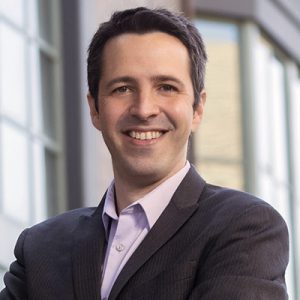Panel Recap: 2023 Grand Challenge and Labor Trends to Follow
The Kenan Institute’s 2023 grand challenge – Workforce Disrupted: Seeking the Labor Market’s Next Equilibrium – has been underway for more than a month, and we’ve begun our exploration of the topic through our insights, commentaries and media content. As we delve deeper, it’s helpful to understand more clearly how we envision academics and researchers speaking to business leaders and industry-side actors – as well as how each can offer insights to help one another develop a broader, shared understanding.
To that end, Paige Ouimet, UNC Kenan-Flagler Business School finance professor and the institute’s research director, moderated a panel at our 2023 Frontiers of Business: The Promise and Peril of Stakeholder Capitalism conference featuring different perspectives on the current state of work. Ouimet spoke with Dan Broekhuizen, vice president of NTT Data Services Leadership Development Center of Excellence; Tamla Oates-Forney, executive vice president and chief human resources officer at USAA; and Ricardo Perez-Truglia, professor at the University of California-Berkeley’s Haas School of Business and 2023 Kenan Institute Distinguished Fellow, to begin the conversation around what labor market trends are of highest interest.
Adapting Work Culture to Meet Changing Worker Preferences
As a human resources professional and practitioner, Oates-Forney focused her comments on the changes she is observing in worker preferences and how employers must adapt to accommodate these shifts. In particular, she emphasized strategic workforce development and what present labor market conditions mean for firms. Between the shortened length of a worker’s average tenure and the tight nature of the labor market, firms are forced to identify specific skills gaps in their workforce and reach out to those segments. She also said that employers need to reimagine the concept of promotion and skill development for existing workers. As new technologies continue to change the skills required by firms, workers will want to build a wider skillset and acquire greater flexibility.
In his responses, Perez-Truglia discussed his research-based approach to understanding labor market dynamics before going on to dissect some of the most relevant findings from his work. Many of his research projects use natural experiments that involve comparing outcomes of a treatment group and untreated control group; this heavily empirical method allows his work to speak to what workers are experiencing on the ground. A particular theme in his research topics revolves around the mindset of workers and how this factors into performance and worker satisfaction. For example, Perez-Truglia found that workers who had chronically underestimated the pay level of their superiors generally performed better when provided with full transparency around pay.
On a similar note, Broekhuizen emphasized the power of employees who feel empowered and included at work, as well as the responsibility of employers to facilitate a culture that fosters these sentiments. Broekhuizen took the stance that the post-pandemic rise of remote work offered an opportunity for employers to transition from a “command and control” approach (which relied upon more direct supervision and less room for worker autonomy) to what he referred to as a “coordinate and cultivate” system. Broekhuizen finds this latter approach essential to the development of workplace culture in a remote work environment; since managers have less direct contact with their employees, they have a reduced ability to closely monitor all of their subordinates’ actions. Subsequently, managers need to be able to put trust in their employees and coordinate actions from a more hands-off approach – which has the added benefit of allowing worker creativity and autonomy to flourish.
Developing Inclusive Workplaces
Inclusivity was also front of mind for all three speakers. Oates-Forney discussed her experiences as a woman of color in spaces that have traditionally been predominantly white and male – as well as the negative stereotypes and mindsets that can occur when a discussion fails to represent all possible demographics. In particular, she emphasized that the needs of a constituency cannot be properly understood if that constituency is not given a chance to speak for itself. Broekhuizen drew upon his experience as an undercover narcotics officer to call attention to workers with a criminal record and how they are frequently stigmatized and locked out of the workforce. Perez-Truglia added to these perspectives by sharing research findings that showed disproportionate benefits accruing to male-identifying employees who work for male-identifying managers. This finding was primarily attributed to greater social outreach made by male managers to their male employees, demonstrating how bias can be deeply embedded into workplace systems even through unconscious action.
From the responses of the three panelists, two dominant themes emerged. The first is that workers’ preferences are changing – whether employers like it or not – and it follows that their employers must be willing to change alongside them. These changes can be physical, such as the migration to remote and hybrid work, or mental, such as changing expectations around job tenure and skill development. Either way, the employees provide the human capital upon which firms rely, and the new labor market equilibrium will need to properly meet their needs.
The second theme is that the current tumult across social, economic and political spheres can be reframed as opportunity – more specifically, as an opportunity to create a more inclusive and flexible ecosystem for work. Over the course of this year, the Kenan Institute will look to foster even more of these discussions to bring the scientific and lived experiences into conversation with each other, with the hope of fostering an informed understanding of how employers and employees can meet each other at an equitable crossroads.

